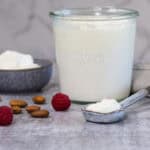Homemade Yoghurt
Want to make thick, creamy yoghurt that's simpler and much cheaper than store bought? Give it a try and see how easy it is to make your own! This recipe makes 2 pints/1 litre of yoghurt.
Servings: 6
Calories: 171kcal
Ingredients
- 1 quart whole milk full fat milk
- 1 cup skim milk powder optional, I use it to thicken and make my yoghurt creamier
- 2 Tbsp unsweetened natural yoghurt from bought unsweetened natural yoghurt or from a previous batch you’ve made
Instructions
Heat the milk
- There are two methods for heating the milk. My preferred way is to use my steam oven as it's more hands-off and you don't risk burning the milk on the bottom of a pan. For this method, pour the milk into a heatproof bowl or deep baking dish. Put it into your oven and set to Steam, 194°F/90°C (100% humidity). Heat for 45 minutes, then remove the bowl and cool until the milk is lukewarm, around 113°F/45°C.1 quart whole milk
- The more conventional method to heat the milk is on the stove. For this, pour the milk into a clean saucepan and heat over medium heat, stirring to stop it from catching on the pan, until it reaches 194°F/90°C on a thermometer. Hold the milk at this temperature, stirring to stop it catching, for 10 minutes. Remove from heat and let cool until the milk is lukewarm, around 113°F/45°C.
Add milk powder and starter yoghurt
- If using, tip the milk powder into the milk and whisk until it dissolves. Whisk in the starter yoghurt until smooth, then pour the mixture into a clean glass jar (or a few smaller jars). Put the lid/s on and place in your steam oven.1 cup skim milk powder, 2 Tbsp unsweetened natural yoghurt
Ferment yoghurt
- Set your oven to Steam 100°F/38°C and leave the yoghurt to ferment for anywhere from 6 to 10 hours. 8 hours is my family's sweet spot, for a yoghurt that's creamy and thick but not too tangy. A longer time will give you more tangy/sour yoghurt if that's what you prefer.
- When finished, remove from oven and chill your yoghurt. It will keep in the fridge for about 2 weeks, and you can use the last couple of tablespoons for your next batch of yoghurt.
Video
Notes
- Milk choice. You can make yoghurt using skim or low-fat milks, but it will affect the texture and thickness of the finished product. I find lower fat milks unreliable and inconsistent for yoghurt. More fat equals a creamier yoghurt, and it also sets better.
- Controlling the yoghurt's thickness and sourness via milk temperature. Heating and holding the milk at 194°F/90°C makes the yoghurt set thicker and with a milder tang. If you like a thinner, more sour yoghurt you can heat to 176°F/80°C instead.
- Cooling the milk. I generally leave the heated milk to cool down on its own, but you can speed up the process by putting the pan into an ice bath and stirring until the milk is sufficiently cooled.
- Yoghurt starter culture. The easiest way to start your first batch of yoghurt is to buy a small tub of good quality, pot set, unsweetened yogurt. I have definitely found differences in my yoghurt quality depending on the starter yoghurt, and I don't recommend using cheaper yoghurts with thickeners, gelatine or other additives. If you are looking to add specific probiotic strains to your yoghurt, there are online suppliers you can hunt down for powdered culture starters.
- Using milk powder. My kids love a very thick and creamy yoghurt, akin to a pot set Greek style yoghurt. Because I'm lazy and don't want to muck around with straining the finished yoghurt (nor think about what to do with the resulting whey), I achieve this by adding milk solids, aka milk powder, to the milk before fermentation. It's totally optional, try it both ways and see which you prefer.
- Fermentation time and temperature. Fermenting yoghurt at a low temperature for a long time is what helps it to set up smooth and soft. You can play with the time and temp to some extent, but be aware that fermenting for too long, or at too high a temperature (over about 42°C for extended periods) can result in yoghurt that's lumpy and grainy, because the whey separates from the proteins in the milk.
- Further reading. This article discusses making yoghurt in a bread proofing appliance, but shares some excellent details about managing time, temp and different ingredients for the best results.
Nutrition
Serving: 150g | Calories: 171kcal | Carbohydrates: 18g | Protein: 13g | Fat: 5g | Saturated Fat: 3g | Polyunsaturated Fat: 0.2g | Monounsaturated Fat: 1g | Cholesterol: 24mg | Sodium: 170mg | Potassium: 605mg | Sugar: 18g | Vitamin A: 698IU | Vitamin C: 1mg | Calcium: 454mg | Iron: 0.1mg
